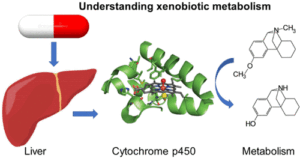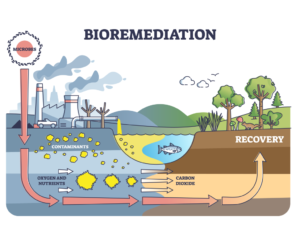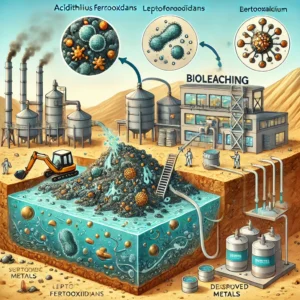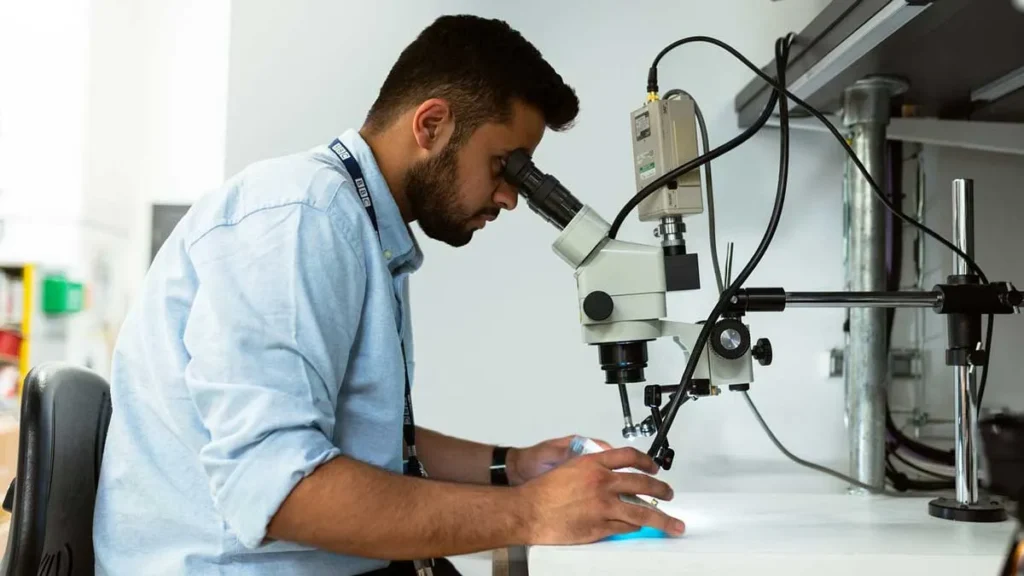Microbial Enzymes Utilization in Biodegradation
Enzymatic microbial metabolism plays a crucial role in the biodegradation of various organic and inorganic pollutants. Microorganisms produce enzymes that catalyze the breakdown of complex compounds into simpler, less harmful substances, which can be further metabolized or assimilated into the environment. Here’s an overview of enzymatic microbial metabolism and its application in biodegradation:

1. Enzymes Involved in Biodegradation
Microbial enzymes are highly specific and efficient in catalyzing reactions. Some key classes of enzymes used in biodegradation include:
a. Oxidoreductases
- Laccases: Oxidize phenolic and non-phenolic aromatic compounds.
- Peroxidases: Degrade lignin and phenolic pollutants.
- Monooxygenases and Dioxygenases: Insert oxygen atoms into pollutants like hydrocarbons, initiating their breakdown.
b. Hydrolases
- Lipases: Break down fats and oils into glycerol and fatty acids.
- Proteases: Degrade proteins into amino acids.
- Cellulases: Degrade cellulose into glucose units.
c. Dehalogenases
- Remove halogen atoms from chlorinated compounds (e.g., pesticides, solvents) to render them less toxic.
d. Lyases
- Break chemical bonds (e.g., carbon-carbon bonds) in aromatic and aliphatic hydrocarbons.
2. Microbial Metabolic Pathways in Biodegradation
Microorganisms utilize metabolic pathways to process pollutants through enzymatic action. These pathways include:
a. Aerobic Metabolism
- Requires oxygen as the terminal electron acceptor.
- Effective in degrading hydrocarbons (e.g., benzene, toluene) through enzymes like monooxygenases and dioxygenases.
b. Anaerobic Metabolism
- Functions in oxygen-limited environments.
- Relies on alternative electron acceptors (e.g., nitrate, sulfate, iron).
- Utilized in breaking down chlorinated solvents (e.g., trichloroethylene).
c. Co-Metabolism
- Microbes degrade a pollutant while metabolizing another primary substrate.
- Involves non-specific enzyme action, e.g., degradation of trichloroethylene during methane oxidation.
3. Applications in Biodegradation
Microbial enzymes are employed in various bioremediation strategies to mitigate environmental pollution:
a. Hydrocarbon Biodegradation
- Enzymes like dioxygenases and hydrolases break down petroleum hydrocarbons in oil spills.
b. Plastic Biodegradation
- Microbial enzymes, such as PETases and cutinases, degrade synthetic polymers like polyethylene terephthalate (PET).
c. Pesticide Degradation
- Dehalogenases and oxidoreductases degrade organophosphate and organochlorine pesticides.
d. Heavy Metal Detoxification
- Enzymes facilitate the precipitation and transformation of heavy metals like chromium and mercury into less toxic forms.
e. Wastewater Treatment
- Microbial enzymes degrade organic matter, ammonia, and phosphates, improving water quality.
4. Mechanism of Action
- Adsorption: Enzymes interact with the pollutant on the microbial surface.
- Enzymatic Hydrolysis: Breaks chemical bonds (e.g., ester, amide) in pollutants.
- Oxidation/Reduction: Alters the chemical structure, making pollutants more accessible for further degradation.
- Metabolism: Pollutants serve as carbon and energy sources for microbial growth.
5. Challenges and Future Directions
- Challenges:
- Low bioavailability of pollutants.
- Toxicity of pollutants to microbial populations.
- Environmental factors (pH, temperature) affecting enzyme activity.
- Future Directions:
- Engineering robust microbial strains and enzymes for enhanced biodegradation.
- Integrating bioinformatics and systems biology for pathway optimization.
- Developing enzyme-based formulations for field applications.
By leveraging enzymatic microbial metabolism, biodegradation offers a sustainable and eco-friendly approach to managing environmental pollutants.
Applications in Biodegradation
Hydrocarbon Biodegradation
Hydrocarbon biodegradation is the process where microorganisms degrade petroleum hydrocarbons into simpler, less harmful compounds. This process is critical for cleaning up oil spills and contaminated sites.
Key Enzymes
- Monooxygenases and Dioxygenases: Catalyze the incorporation of oxygen into hydrocarbons, initiating degradation.
- Hydrolases: Break down hydrocarbon derivatives, such as esters.
- Catalases and Peroxidases: Detoxify reactive oxygen species generated during hydrocarbon metabolism.
Microbial Species
- Bacteria: Pseudomonas sp., Alcanivorax borkumensis, Mycobacterium sp.
- Fungi: Aspergillus sp., Candida sp.
Mechanism
- Activation: Enzymes like monooxygenases oxidize hydrocarbons.
- Breakdown: Intermediate products, such as alcohols and acids, are further oxidized.
- Mineralization: End products include CO₂, water, and biomass.
Applications
- Oil spill cleanup.
- Bioremediation of soil contaminated by industrial effluents.
Plastic Biodegradation
Plastic biodegradation involves breaking down synthetic polymers into monomers through microbial enzymes.
Key Enzymes
- PETases and MHETases: Degrade polyethylene terephthalate (PET).
- Cutinases: Hydrolyze polyesters.
- Laccases: Oxidize aromatic compounds in plastics.
Microbial Species
- Bacteria: Ideonella sakaiensis (PET degradation), Pseudomonas sp.
- Fungi: Aspergillus niger, Penicillium sp.
Mechanism
- Adherence: Microbes attach to plastic surfaces.
- Enzymatic Hydrolysis: Enzymes break ester or amide bonds in polymers.
- Metabolism: Monomers are metabolized into biomass, CO₂, and water.
Applications
- Reducing plastic waste in landfills.
- Developing biodegradable plastics with microbial integration.
Pesticide Degradation
Pesticide degradation involves breaking down toxic agrochemicals into non-toxic or less toxic forms through microbial enzymes.
Key Enzymes
- Dehalogenases: Remove halogen groups from organochlorines.
- Hydrolases: Break ester bonds in organophosphates.
- Oxygenases: Oxidize aromatic rings in pesticides.
Microbial Species
- Bacteria: Flavobacterium sp., Rhodococcus sp.
- Fungi: Trichoderma sp., Phanerochaete chrysosporium.
Mechanism
- Hydrolysis: Breaking chemical bonds in pesticides.
- Oxidation/Reduction: Alters chemical structure for further degradation.
- Complete Degradation: Converts pesticides into CO₂, water, and biomass.
Applications
- Cleaning pesticide-contaminated soil and water.
- Reducing pesticide residues in agricultural runoff.
Heavy Metal Detoxification
Heavy metal detoxification involves microbial processes that transform toxic metals into less toxic or inert forms.
Key Enzymes
- Oxidases: Oxidize metals (e.g., Cr³⁺ to Cr⁶⁺).
- Reductases: Reduce metals (e.g., Hg²⁺ to Hg⁰).
- Phytochelatins and Metallothioneins: Bind metals for sequestration.
Microbial Species
- Bacteria: Bacillus sp., Shewanella sp., Pseudomonas sp.
- Fungi: Aspergillus niger, Penicillium sp.
Mechanism
- Biosorption: Microbial cell walls bind heavy metals.
- Biotransformation: Enzymes convert metals to less toxic forms.
- Precipitation: Metals precipitate as inert compounds.
Applications
- Treatment of industrial effluents.
- Bioremediation of heavy metal-contaminated soils.
Wastewater Treatment
Wastewater treatment uses microbial enzymes to degrade organic matter and remove pollutants, including nitrogen, phosphorus, and heavy metals.
Key Enzymes
- Ammonia Monooxygenase (AMO): Converts ammonia to nitrite.
- Nitrate Reductase: Reduces nitrate to nitrogen gas.
- Hydrolases: Break down organic matter (proteins, fats, carbohydrates).
Microbial Species
- Bacteria: Nitrosomonas sp., Nitrobacter sp.
- Fungi: Trametes versicolor (laccase production).
Mechanism
- Primary Treatment: Removes large particles and solids.
- Biological Treatment: Microbes degrade dissolved organic matter.
- Advanced Treatment: Removes remaining nutrients, metals, and pathogens.
Applications
- Municipal and industrial wastewater treatment plants.
- Bioreactors for nutrient recovery and recycling.
By utilizing microbial enzymes, these processes significantly contribute to environmental sustainability and pollution mitigation.










